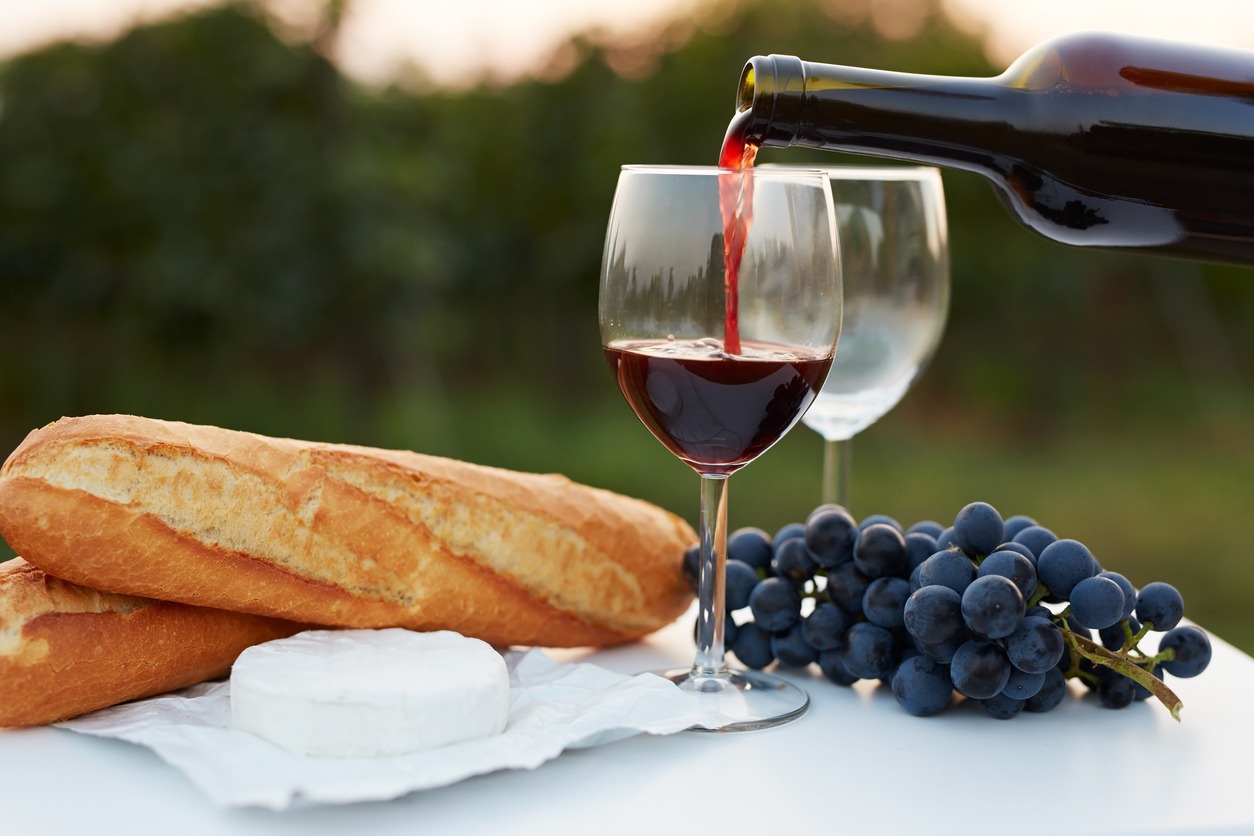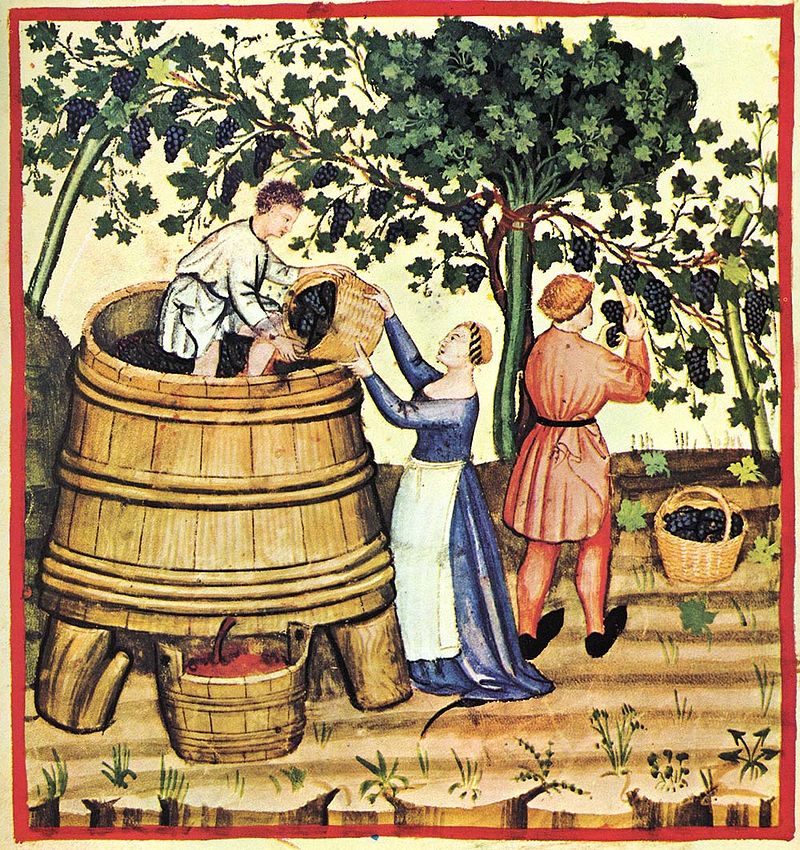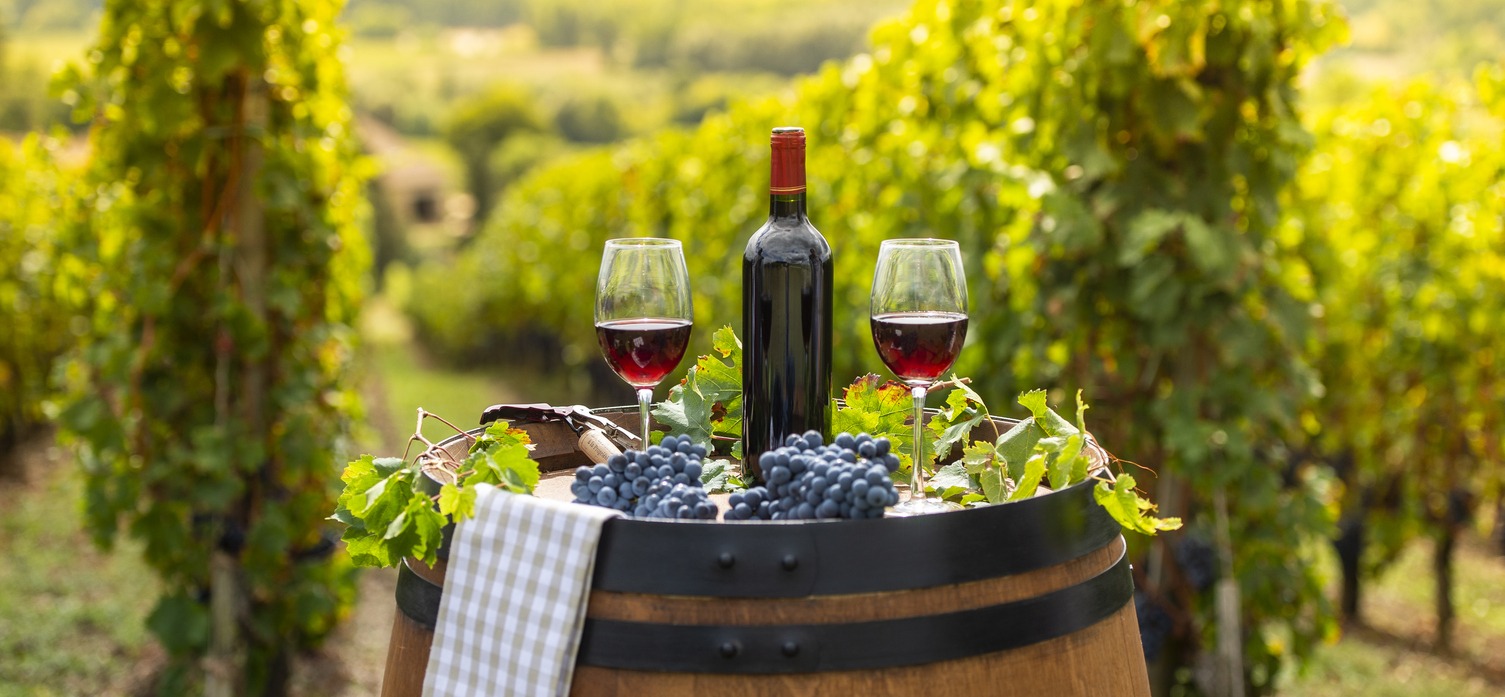French wines are some of the finest in the world. The country has been a key player in shaping the world of wine, and its vineyards are renowned for producing some of the finest wines globally. But did you know that the French weren’t the first to makes wine? Some people may be surprised to know that, but as anyone who has sipped a Bordeaux, Champagne, or Burgundy can tell you –the French got pretty good at it. And thanks to some molecular archaeology, researchers can now confirm they picked up these skills as early as 425 B.C.
Throughout its long history, the French wine industry has been influenced by both domestic and international forces. Before the French Revolution, the Catholic Church owned vast vineyards, exerting considerable influence in regions like Champagne and Burgundy, where the concept of terroir took root. These internal and external influences made the French wine industry a dominant force in the world for most of its history, with many of its wines setting the standard for their respective styles.
Here’s what you need to know to learn about the history of wine and winemaking in France.
The History of Winemaking in France
The history of French wine spans over 2600 years, dating back to the establishment of Massalia in the 6th Century B.C. by Phocaeans. There is a possibility that viticulture existed even earlier than this. The Romans played a significant role in spreading viticulture throughout the region known as Gaul, cultivating vineyards in areas that would later become famous wine regions like Bordeaux, Burgundy, Alsace, Champagne, Languedoc, Loire Valley, and the Rhone.
Origins of French Wine
The Eurasian grape Vitis vinifera, which accounts for 99 percent of the world’s wine, was first domesticated around 9,000 years ago in the Near East’s mountainous regions. The wine culture spread across the Mediterranean with the involvement of Canaanite, Phoenician, and Greek merchants.
Around the eighth Century B.C., the Phoenicians assisted the Etruscans in establishing vineyards in central Italy, leading to the growth of the Etruscan wine industry. Within 200 years, the Etruscans, like the Phoenicians, started exporting wine to southern France by building ships for transportation.
Upon experiencing the Etruscans’ wine, the French were inspired to start their own wine production. Within a relatively short period, grapevines were introduced, and local wine production began in southern France, likely under Etruscan guidance initially.
Further evidence of early wine production in France was found in a pressing platform from Lattara dating back to about 425 B.C. Chemical analysis confirmed that it was used as a wine press and provided the earliest chemically identified date for winemaking in the region, suggesting that the French were likely making wine even earlier.
The early history of wine in Gaul, now modern-day France, dates back to ancient times, with evidence suggesting that the Celts were the first to cultivate the grapevine Vitis vinifera. Archaeological findings show grape pips throughout France, pre-dating the influence of the Greeks and Romans. Greek settlers, who arrived in the 6th Century B.C., introduced Mediterranean viticulture practices and focused on warm, coastal regions where vines thrived alongside olive and fig trees.
Roman Influence
Under Roman rule, starting from the 2nd Century B.C., Italian wine dominated the region, as indicated by amphorae fragments found throughout Gaul. Only in the 1st Century A.D. did Gaul’s wine begin to gain recognition. Notably, Pliny the Elder mentioned the Allobroges’ resinated wine from the Rhone region, which held high regard.
During the late 1st Century B.C. and early 1st Century A.D., viticulture expanded to areas beyond the Mediterranean climate, utilizing the biturica grape variety, an ancestor of cabernet varieties. The demand for wine and the cost of transportation fueled this expansion. Large-scale amphorae production near Bézier and Gaillac suggested the warm climate suitable for reliable harvests.
Viticulture continued to spread in the following centuries, reaching Bordeaux, Burgundy, the Loire Valley, the Île-de-France (including Champagne), and Brittany by the 6th Century A.D.
The decline of the Roman Empire brought changes to Gaul as Germanic tribes invaded the region. The southern areas, where wine was abundant, contrasted with the northern regions, where viticulture was more challenging. Wine became a symbol of status and a luxury item in the north, while the Christian Church’s influence further solidified wine’s significance in France, especially as part of the sacrament of the Eucharist. It’s worth noting that wine also had a role in pagan rituals, as evidenced by the discovery of a silver wine dipper at Pont-de-Leyris.
Medieval Wine History: The Monks’ Influence and Rise of Bordeaux
During the Middle Ages and the Age of Enlightenment in France, significant developments took place in the wine industry.
During this time, the monastic orders – especially the Benedictines and the Cisterians – maintained vineyards and conserved winemaking knowledge and skills. They had the resources, motivation, and security to produce a steady supply of wine, both for making money and celebrating mass. Monks from the Roman Catholic church had an essential influence on the history of Burgundy wine. Before the French Revolution, the best wines in Burgundy were produced by monasteries.
The move of the papacy from Rome to Avignon in 1305 brought attention to the wines of the Rhone and Burgundy regions due to their preference by the Avignonese popes. This increased the prominence of Burgundy wines, and the Valois Dukes of Burgundy saw the potential to leverage the wines for power and status.
During the 12th Century, Bordeaux became a prominent wine region – thanks to the marriage of Eleanor of Aquitaine to King Henry II of England. The region’s wine gained popularity in England and beyond. The Bordeaux-English wine trade reached its peak prosperity in the 14th Century but declined during the Hundred Years’ War when Gascony returned to French control. Dutch wine traders then took on a more significant role in Bordeaux, becoming key players in the French wine industry throughout the 16th and 17th centuries.
During the Middle Ages, the landownership system of complant became prominent, leading to the expansion of vineyards on uncultivated lands. Under complant, farmers approached landowners with offers to plant and tend to the land for a specified period. After this time, half of the cultivated land returned to the landowner, while the other half belonged to the farmer, who paid a portion of each year’s crop to the landowner. This practice led to the efficient planting of vineyards in various regions of France, and the name “Quarts de Chaume” in the Loire Valley wine originated from this system.
Trade and transportation were crucial in the wine industry during this era. Wine regions located close to navigable rivers, like the Loire and Garonne, found it easier to trade with other regions and countries. Port cities such as Bordeaux, La Rochelle, and Rouen became major centers of wine commerce, facilitating the trade of wines from regions like Gascony, Haut Pays, Poitou, and Île-de-France. Political alliances also influenced the wine trade, with relationships between Bordeaux and England and the Auld Alliance between France and Scotland enhancing access to French wines in those countries.
French Revolution to Phylloxera

The French Revolution led to a notable increase in producing poor-quality French wine. Jean-Antoine Chaptal, Napoleon’s Minister of the Interior, believed that the lack of knowledge among many French vignerons about emerging winemaking technologies contributed to this decline in quality. Also, the vineyards owned by the church and the nobility were confiscated during that era.
But by the mid-19th Century, the wine industry in France rose up and experienced a golden period of prosperity. The emerging bourgeoisie class became strong consumers of wine and culinary products. Bordeaux, especially the Gironde region, witnessed a surge in demand from both the Parisian market and its steady trade with England.
In 1855, Emperor Napoleon III commissioned the Bordeaux merchants to create a ranking of the region’s wine estates for the Paris Exposition. The resulting 1855 classification of Bordeaux became one of the most renowned rankings of wine estates globally. French wine became a vital aspect of the economy and a source of national pride, earning international recognition as the benchmark for wine quality.
However, this golden age eventually faced challenges. The 19th-century scientific interest in collecting botanical species inadvertently introduced new diseases to populations without natural resistance. North America, in particular, brought several grape ailments that devastated the French wine industry. The introduction of powdery mildew in the 1850s significantly affected grape quality and yields. The 1854 vintage was particularly hard-hit, yielding the smallest harvest in over 60 years. The solution came in 1857 when Henri Marès developed a technique of sulfuring vines to combat oidium.
As French vignerons recovered from oidium, a new problem arose with the arrival of a mysterious ailment causing grapevine decay and death. This problem was caused by the tiny louse, phylloxera, which originated from North America and targeted vine rootstocks. The solution to this epidemic also came from North America, involving grafting naturally resistant American rootstocks to European vines. While this helped stave off the phylloxera epidemic, it brought new issues, such as the appearance of the fungal diseases downy mildew in 1878 and black rot in the 1880s.
The devastation of French vineyards opened the door to experimentation with new plantings. Vignerons began to explore hybrid plantings, initially using American hybrids (such as Delaware and Clinton) with genes from resistant American vine species and later turning to French hybrids (like Chambourcin and Vidal blanc) that produced wines with flavors more akin to European Vitis vinifera.
20th Century
In the late 19th Century, the French government enlisted Louis Pasteur to investigate the wine industry issues. His groundbreaking research significantly influenced the science of French winemaking, recognizing the benefit of adding tartaric acid and oxygen’s crucial role in the aging and improvement of wine.
Pasteur’s work unveiled various causes of wine spoilage, some of which could be managed during winemaking. Additionally, Pasteur’s investigation explained the issue of Burgundy wine turning into vinegar during long voyages to England, which was caused by the bacterium Acetobacter. His discoveries revolutionized winemaking knowledge in France and eventually spread to wine regions worldwide.
The development of railway systems opened up new trade opportunities for French wines. Regions previously dependent on river transportation now had easier means to transport their wines, leading to increased commercial interest. The Languedoc region, in particular, saw vast expansion and became known for producing numerous light and simple wines shipped across France. Many of these wines were enhanced in alcohol, color, and weight with the addition of Algerian wine from the French colony in Africa, impacting the Algerian economy significantly until the country’s independence in the mid-20th Century. For more information on the Languedoc region, you can read our article, Reasons Why Languedoc is an Ideal Region for Producing Winemaking.
The 20th Century brought about two world wars that devastated some French wine regions. However, it also led to a renewed focus on reorganizing the country’s wine industry. The establishment of the Institut National des Appellations d’Origine (INAO) and the Appellation d’origine contrôlée (AOC) systems, led by Baron Pierre Le Roy, a producer from Châteauneuf-du-Pape, emphasized the identity of French wines and the concept of terroir.
Terroir is a term that refers to the unique combination of natural factors linked to a specific vineyard. It encompasses various factors, such as soil composition, underlying rock, elevation, terrain slope, sun orientation, and climate (including temperature, humidity, rainfall, and winds). When the same grape variety is grown in different terroirs, it can yield wines with strikingly distinct characteristics. This principle forms the foundation for the Appellation system.
Post-War Wine in France
After World War II, the French wine industry experienced significant modernization and increased exports. French wines gained worldwide recognition for their quality and became an integral part of French culture and heritage.
In cooperation with the European Union, various programs were implemented to address the “wine lake” surplus problem, including uprooting less desirable grape varieties and providing technical training to vignerons in viticulture and winemaking.
As we entered the 21st Century, some segments of the French wine industry flourished while others faced challenges and uncertainty. The era brought significant changes occurred due to shifts in the global market and increasing competition from other European wine regions like Italy and Spain. Additionally, emerging New World wine producers from regions such as California, Australia, and South America also presented formidable competition. This changing landscape has marked a new era for the French wine industry.
Wine Regions in France
The wine regions of France show a wide diversity in climate, soil types, and winemaking traditions. Additionally, the orientation of vineyards, hills, slopes, and prevailing winds significantly influences the micro-climate of each region, leading to the production of wines with distinct characteristics and varying quality across different appellations.
Each of these wine regions and appellations boasts its unique historical background, and together, they form the rich tapestry of French wine history.
Here are the famous wine regions in France:
Bordeaux
Bordeaux holds the esteemed title of being the largest fine-wine region in the world, renowned for its remarkable Cabernet and Merlot grape varieties. Within Bordeaux, the Sauternes area, including Barsac, stands out for producing its renowned dessert wines.
Geographically, the Bordeaux region is naturally divided by the Gironde Estuary, giving rise to the Left Bank area, famous for wines dominated by Cabernet Sauvignon, and the Right Bank, known for wines that prominently feature a large percentage of Merlot grapes.
Bordeaux is also home to the world’s finest, sweetest white wines, coming from its Sauternes vineyards.
Champagne
Some people use the term “champagne” as a generic term for sparkling wine, but the truth is only sparkling wines produced in this region can be officially labeled as “Champagne.”
The Champagne region, located in northeast France, is renowned for its world-famous sparkling wine that bears the same name as the region. The finest Champagnes are cherished for their unique blend of freshness, richness, and delicacy, making them a true delight for wine enthusiasts.
The region primarily cultivates three main grape varieties: Pinot Noir, Pinot Meunier, and Chardonnay, which are also the key components in producing authentic Champagne.
Burgundy
Burgundy, also known as Bourgogne, is renowned for its iconic wines, often called ‘Burgundies.’ These wines are distinctively dry reds crafted from Pinot Noir grapes and whites made from Chardonnay grapes. In addition to these, the region is also celebrated for using Gamay grapes in producing the famous Beaujolais Nouveau.
Burgundy’s main wine regions stand out, including Côte d’Or, Chablis, Mâconnais, and Beaujolais. Each of these regions contributes to the diverse and exceptional wines that Burgundy is recognized for worldwide.
Alsace
Located in the northeastern part of France, Alsace is renowned for its exceptional white wines. Influenced by its Germanic heritage, the region utilizes grape varieties that are similar to those found in German winemaking.
Alsace and Austria and Germany are recognized for producing some of the finest dry Rieslings globally, showcasing their expertise in this style. Additionally, the region is celebrated for crafting highly aromatic Gewürztraminer wines, adding to its reputation as a producer of exceptional white wine varieties.
Loire Valley
The Loire Valley wine region includes several French wine regions situated along the Loire River, stretching from the Atlantic coast’s Muscadet area to the eastern regions of Sancerre and Pouilly-Fumé. In the heart of the valley, you’ll find Touraine and Anjou, known for producing sweeter wines crafted from the Chenin Blanc grape variety native to the Loire.
The wines from this picturesque region are renowned for their lightness, refreshing qualities, and fruit-forward aromas, complemented by noticeable acidity. Noteworthy varieties include Muscadet wine from the Atlantic coast, Sauvignon Blanc from the limestone hills of Sancerre, and Chenin Blanc from the central Loire, commonly used in producing sparkling wines known as Crémant de Loire within this area.
Provence
Located in southeast France, the Provence wine region has a notable reputation for producing delightful rosé wines. Notably, Bandol stands as the most esteemed appellation within Provence, celebrated for its exceptional red wines.
Mourvèdre is the primary grape variety cultivated throughout Provence, employed in the crafting of numerous red wines and rosés. Additionally, other essential grape varieties in the region include Grenache, Cinsault, and Carignan.
Rhône
The Rhône wine region, situated in the south of France along the Rhône valley, is renowned for its remarkable diversity, producing a wide range of wines from full-bodied reds to fruity reds and dry, full-bodied whites. It’s the region that crafts red wines made of Syrah/Shiraz and Grenache Noir grapes and white wines made from Viognier, Marsanne, and Roussanne.
Rhône’s red wines offer a spectrum of flavors, ranging from intensely tannic and concentrated to relatively simple with pleasing depth and fruity notes. The finest reds in this region exhibit remarkable depth, length, and a mature, lingering harmony reminiscent of the greatest Bordeaux wines.



